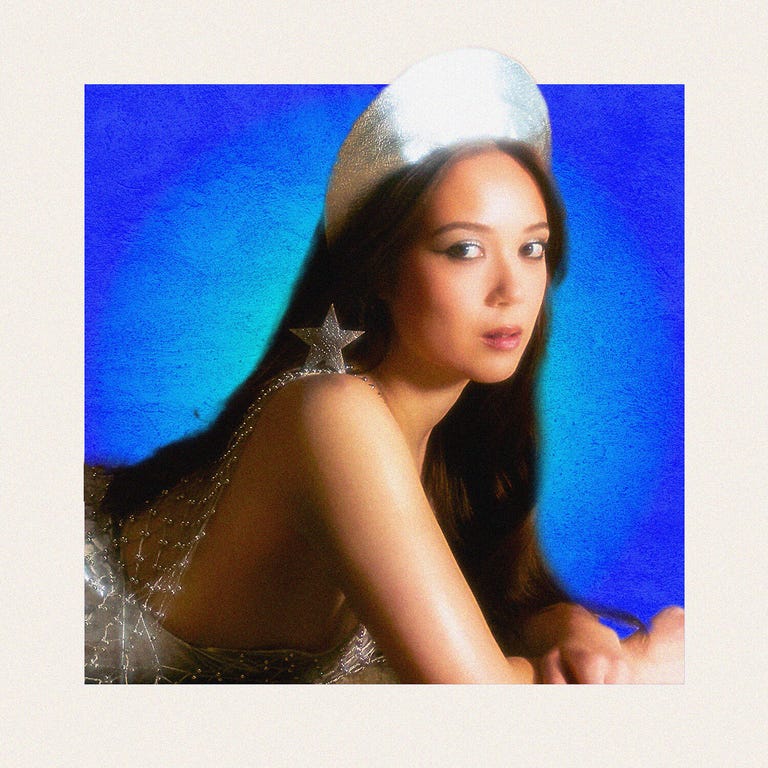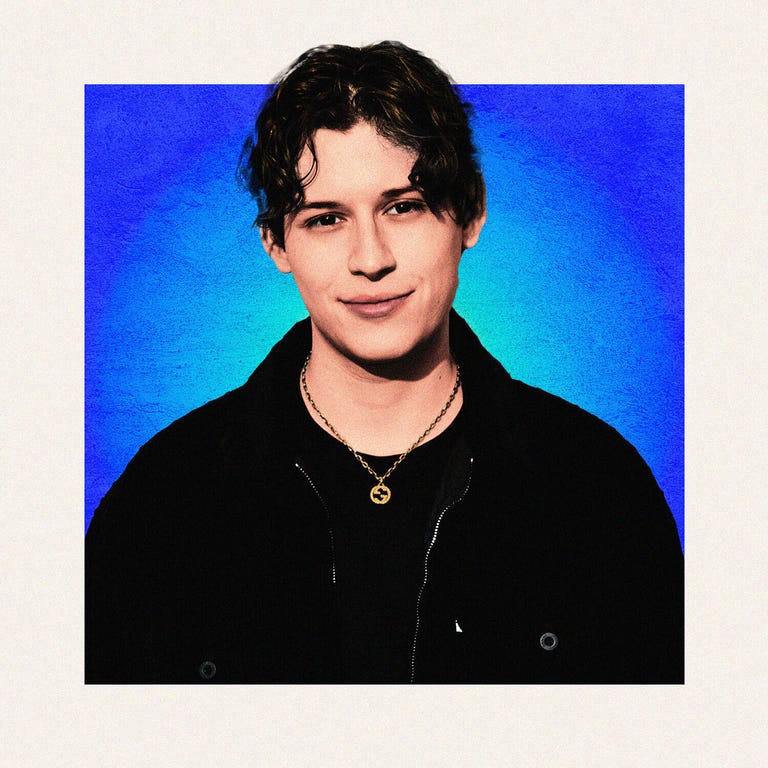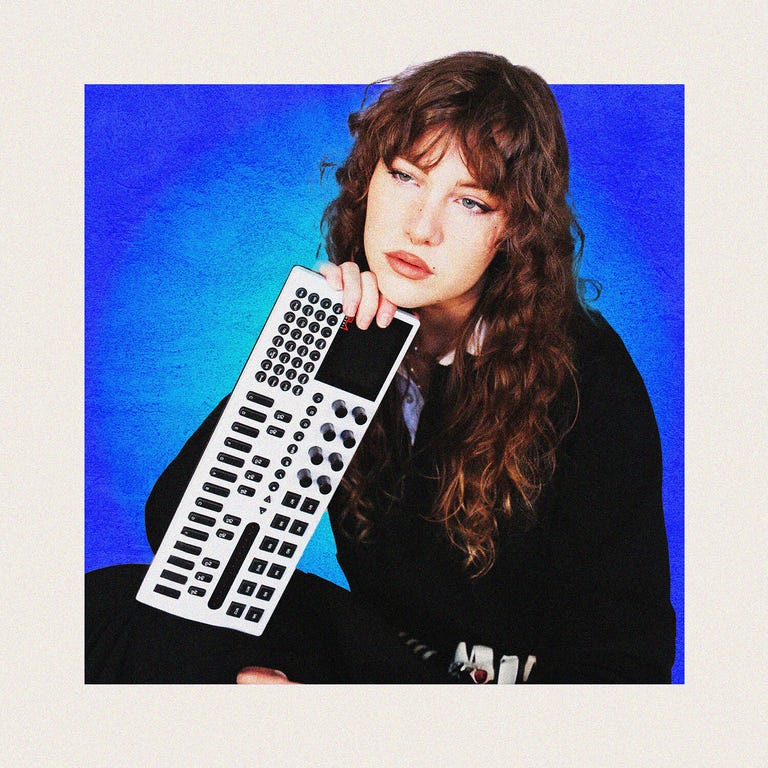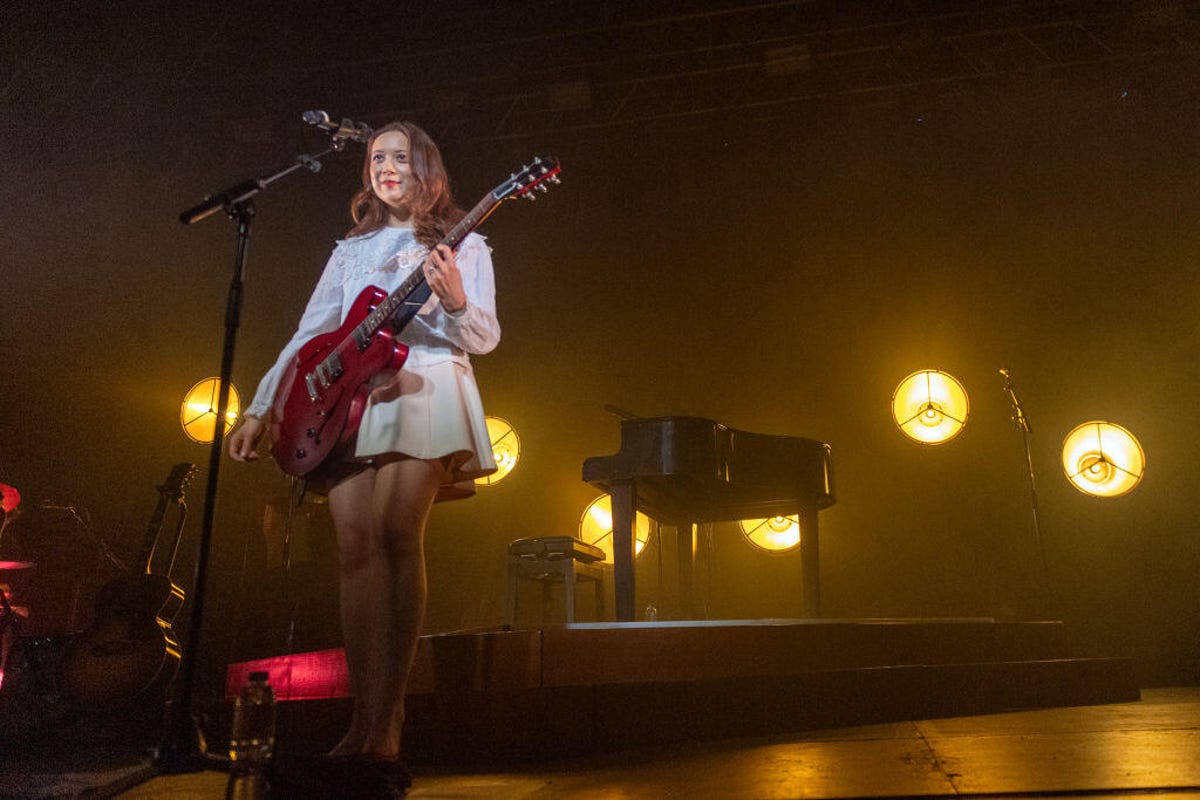“Maybe I should run, I’m only 21, I don’t even know who I want to become,” sings the woman with 4 million TikTok followers who sounds like she’s from another era entirely.
She’s on stage in an industrial warehouse in Glasgow, Scotland, on a Monday night in early 2024, but it could as easily be a 1930s jazz club. A double bass player and drummer are riffing in the shadows, while in the warm haze of diffused lights, the singer’s elegant and melancholic voice washes over a crowd of girls with bows in their hair.
This is exactly the kind of show I frequently attend – a female singer-songwriter, an audience of enraptured women. But Laufey (pronounced lay-vay) is a very different type of musician, a kind I’ve never seen before and might not have if it weren’t for TikTok.
Now 24, the Icelandic-Chinese composer/singer/songwriter/multi-instrumentalist has said in interviews that she’s as much influenced by Chopin, Liszt, Billie Holiday and Ella Fitzgerald as she is Taylor Swift. Her musical career has taken her from performing as a soloist on cello with the Iceland Symphony Orchestra at 15 through to graduating Berklee College of Music in Boston, to now, when you have to beg, borrow or steal if you hope to score a ticket to her sold-out tour (I only did the first two).
By the time I see Laufey, her elegant, velveteen voice warming up that drafty warehouse, I’ve been on an entire sonic journey on TikTok and across the internet, discovering artists I never knew existed and signing on as a member of the Laufey fanclub (or Lauvers, as we’re know).
The young TikTok star is fresh from performing at the Grammys a week prior – but the audience here, on the second night of her first European tour, lives for the Laufey they see on the small screen in their pockets, rather than the one on a primetime broadcast. She might be a classically trained musician known to the Recording Academy for her jazz-inflected sound, but to her fans, she’s Laufey who runs a bookclub on Instagram and Laufey who participates in the same TikTok trends they do. They stood outside in wintry rain and hail to finally see her up close. On stage, Laufey praises the crowd’s resilience: “I was getting DMs from you guys, saying ‘Let me in.'”
As with many of her Gen Z contemporaries, Laufey’s success has come at least in part by way of TikTok. The China-based platform, which has over 1 billion users worldwide and almost 150 million active users in the US alone, is arguably the most influential destination right now for rising musical superstars to get discovered (the others being platforms like Spotify and Soundcloud) by labels and by fans.

Laufey
“That’s the beauty of the TikTok experience – that you can be an emerging artist who comes up there,” says Lisa Skeppner, music partnerships manager at TikTok. “You post five videos and your sixth really connects and it goes viral.”
For us, the listeners, it’s a chance to have our minds opened to music that might never have otherwise come our way and an opportunity to appreciate the creativity, skill and expertise that goes into making that music.
TikTok has long been understood as a viral hitmaker, but artists, producers and tastemakers, often armed with little more than a smartphone, a ring light and a mic, have also turned it into a hub of creativity. It’s become a venue for collaboration with their fans and other artists. It’s a sanctuary where diverse talent can showcase everything they’re capable of on their terms, making connections and building communities from the relative safety of their bedrooms. For some, it’s paved the way to life-changing record deals, while for others, TikTok is a way to bypass industry gatekeepers who don’t believe in them or have held them back.
There’s room for everyone to thrive. Whether you play the church organ or make beats from household objects, it’s a place to find inspiration, collaborators and audiences. If you’re really fortunate, TikTok can catapult you onto the Coachella lineup, Grammy stage or Barbie soundtrack – or, if you’re Ice Spice, all three.
In this article:
Success such as this is rare, but the power of digital platforms is that they create space for musicians to succeed outside of the industry’s constraints – which, right now, include keeping artists’ music off TikTok altogether if you’re Universal Music Group, after the two sides failed to agree on the terms for a contract renewal: largely over matters of artist compensation, but also AI-generated music and online safety. That rupture, which hit at the end of January, just days before the Grammys ceremony, has cast a cloud over the TikTok music scene, especially for fans who make their own dance videos, and it’s unclear how the clash will play out.
What is clear is that who has creative control, who gets to be tastemaker and who gets to be heard is no longer simply in the hands of record company executives. Just as streaming services have put a truly incomprehensible number of songs at our fingertips, TikTok has shown there is infinitely expansive room available for people to make music and connect with audiences.
You may well have preconceived notions about the music that Gen Z (roughly, those now between the ages of 12 and 27) is making and listening to – even as a millennial TikTok user, I know I did. But the truth I’ve discovered is that the Gen Z music scene is thrillingly diverse, and in writing this piece I’ve been transported around the world before landing in a venue just down the road, watching a woman play a cello as a crowd of teenage girls (and some in their twenties and thirties) pointed their cellphones back at her.
Our brave, new, genre-fluid world
The question “Is Laufey jazz?” has been hotly debated across Reddit and YouTube, and was reignited following her Grammy nomination last year. She scored her award win at the 2024 Grammys event in the category of traditional pop album, though her music is most frequently compared to jazz standards from the middle of the 20th century.
A puzzler, to be sure, but one that rather misses the point of Laufey, and of Gen Z music trends altogether. Laufey is at the same time a pop princess with an old soul, a young ambassador for a venerable musical genre and a classical virtuoso with a mainstream fanbase. Speaking on the Glasgow stage about her shared love of classical, jazz and pop, Laufey says that with her Grammy-winning album Bewitched she “just wanted to find a way to mix them all.”

Ari Elkins
Spotify is increasingly introducing playlists based on vibes rather than genres, some (look up the enigmatically named “Pollen” and “Lorem”) tied together with a vague genre-fluid theme. What we once understood as “genre” is now “feeling,” according to playlist curator Ari Elkins.
The 23-year-old had a summer A&R internship with Warner lined up when the pandemic hit. It clearly would have been a good fit. As a TikTok creator, Elkins has found his niche in helping people discover new songs and artists and clearly has a knack for trendspotting in the oversaturated world of music streaming, and last year launched his own label, Blue Suede Records.
Along with 2.2 million TikTok followers, he has over 200,000 followers on Spotify, where he makes playlists with titles such as “Late Night Drive,” “Saturday At Noon” and “Let’s Go On An Adventure.”
“People want music that makes them feel a certain way, and that’s the real genre,” he says. “Artists are doing a great job as well as in being genre-bending themselves.”
One of the biggest artists to have found fame off the back of TikTok is 22-year-old PinkPantheress. The British star went from making music in her bedroom to having a song on the Barbie soundtrack and landing a BillBoard 100 spot last year thanks to her collaboration with TikTok sensation Ice Spice.
But critics and fans alike have struggled to concretely link her sound to a specific genre. Instead, it’s been described variously as bedroom pop, drum and bass, alt pop, dance, garage, jungle and breakbeat. Her collaborations with other artists have seen her stray further still across an entire spectrum of niche subgenres.
What defines her sound more readily than any of these descriptors is her tendency to sample tracks widely, from Spandau Ballet to Linkin Park. Layered with her sweetly distorted vocals, this is the essence of her unique sound that reaches both backward and forward in time.
In generations past there was often embarrassment attached to listening to anything your parents might have been into the first time around, but many Gen Z music fans seem to be liberated from this stigma. Their digital nativism means they’ve grown up with the entirety of the Spotify or Apple Music streaming catalog at their fingertips, and they roam freely and widely across decades and genres in search of music that resonates with them.
On TikTok, Skeppner has worked both with new Gen Z artists and with icons such as the Rolling Stones and Kylie Minogue, and has witnessed artists of all ages and specialties resonate with the platform’s audiences. “What’s so nice with TikTok is that it really is a mix and boundaryless, I would say in terms of both genres, but also ages and types of music,” she says.
Responding to this, Gen Z artists are fearless in their willingness to make the old new again – whether that be PinkPantheress producing songs inspired by Eminem and Craig David, Laufey combining ’40s jazz standards with contemporary heartbreak or Olivia Rodrigo layering her own teen rage and angst on top of Paramore’s pop punk anthem Misery Business.
Gen Z’s genre-fluid listening tastes mean they’re also embracing music from artists from far outside their own cultures. K-Pop and Afrobeats are two of the best-known non-Western genres to make serious waves in the US and other English-speaking countries, but even smaller music movements are finding audiences among new fans who without the internet might never have known of their existence.
According to Spotify’s 2023 Culture Next report, which provides insight into its Gen Z users’ listening habits, “the viral nature of digital platforms is also amplifying once-niche, hyper-local sounds,” such as sierreño, banda and corridos from Northern Mexico, and amapiano, kwaito and gqom from South Africa.
Once upon a time, if you wanted a career as a musician, you first needed to break through in your home country – or even state or city – before growing a foreign fanbase on top of your local success. With platforms like TikTok, that’s no longer the case. For young artists, this means sometimes their fans can be concentrated far away from their home market.
The TikTok effect
When British artist Chinchilla released her viral hit Little Girl Gone on TikTok in 2023, she was surprised to find that it was resonating more strongly in the US than the UK. People assumed she was American, and she had labels reaching out to her from all over the world, she tells me over Zoom from her bedroom in London.
“You’re able to reach people on the complete opposite side of the world without even meaning to,” she says. “It’s a good little joke from fate.”

So Wylie
“A lot of my audience are talented musicians or music lovers – I respect them and I am actively trying to impress them,” says Wylie. “This pushes me to try new production techniques in the hopes of inspiring people to make their own art.”
TikTok has introduced features that help fuel this co-creation process – and has more in the works. “On TikTok, the little piece of magic is the duet feature, because that really allows for artists or fans to be kind of virtually close up,” says Skeppner. The tool lets anyone on TikTok repost other people’s videos with their own video side by side, adding their voice or instrumentation to an original track.
Many of the viral songs you might have heard on or from TikTok are also the sped-up or slowed-down versions of what the artist originally put out. This trend has become so popular that now labels are pushing out these versions of their artists’ songs, says Skeppner, but that’s not how it started.
“Originally it was fans just remixing and changing and amending,” she says. It can be a sensitive matter to artists, she adds, but can also give a song a second life or an entirely different feel. Raye’s hit Escapism is a classic example of a track that scored its viral moment thanks to fan tinkering. Says Skeppner: “It was her fans really, and her leaning into it.”
A place to experiment
Many TikTok artists and producers use the platform not only as a way to promo new music, but to experiment and crowdsource opinions on new material. Stars including Charlie Puth and Tom Odell have teased upcoming releases there, and sometimes the clamor over a snippet posted to TikTok has moved up the release schedule for songs, says Skeppner.
From an artist’s perspective, the feedback from TikTok can play a key role in the creative process. “TikTok specifically has a low-key energy to it that allows me to be playful with the types of music I post,” says Wylie.
It’s easy for musicians to get caught up in the idea of making everything perfect before putting it out into the world, she adds, but on TikTok she can post snippets without the pressure of an official release date. “Though it might seem counterintuitive, I actually find the fickleness of the algorithm helpful in that particular respect,” she says. “I never expect anything from it, so that makes it easier to just put stuff out there.”
During the pandemic singer/songwriter/producer Ellie Dixon really went all in on music – and on TikTok. She was making beats from household objects, creating harmonies to layer on top of other people’s music, writing her own verses to popular songs and slotting them in using her production skills.

Laufey on stage in Glasgow, Scotland, on Feb. 12.
Going live
Making music from the safety of your bedroom is all well and good, but at some point, especially if you score a record deal, you’re probably going to have to get up on stage in front of a live audience.
The music industry still relies on ticket sales to make money (PWC estimated the global live music ticket market was worth $23 billion in 2023), and even TikTok is getting in on the action. Late last year it announced a partnership with Ticketmaster that allows artists to sell tickets to their shows directly through the app. Last December, it even ran its own festival, In The Mix, in Mesa, Arizona, which featured artists from its Elevate program and established stars including Niall Horan and Cardi B.
For some young artists, the jump to the stage comes naturally, but for others, more used to performing to cameras instead of crowds, it’s not always an easy transition. But it can also be remarkable to see how quickly some young artists adapt to the demands of touring life. When 19-year-old artist Gayle, who went viral on TikTok in 2021 with her hit ABCDEFU, canceled her “Avoiding College” tour in 2022, she gave the reason as: “I’m learning how to be an adult.” By the following summer, she was supporting Taylor Swift and Pink on their stadium tours.
Dixon has undergone a similar change of heart about playing live – even though it’s been “a trial by fire” to get there. Her first gig after COVID was on the BBC Introducing stage at the Latitude Festival in Suffolk, England. The day started with a panic attack in the tent, but once she was on stage and could see people wearing her merch and singing her words back to her, it all changed. Now, having toured extensively – both as support to the band Pentatonix and as a headliner – she loves it.
Learning to talk to the audience was a challenge, but now it’s her favorite bit. “At my last tour people were saying that it felt more like a standup show.” She even brings the collaborative spirit of her TikTok persona on stage with her – writing silly songs with her audience (and posting them online later).
There’s no reason that TikTok stars hitting the stage need to follow conventional gig parameters, says Dredge. Mixing in traditional musical performances with what they’re known for on the internet, plus some audience interaction that mimics the comment section, may even be a better fit for meeting fans’ expectations.
Laufey, known for being a serious virtuoso and for wistful, yearning lyrics, leans into this by revealing herself with sarcastic quips between songs. Lit by a single spot during her Glasgow show, she is at times an ethereal princess playing the piano or cello. The next moment, she’s sassily impish, side-eying Valentine’s Day and bopping around coquettishly while holding up bunny ears behind her twin sister Junia, who’s on stage with a violin to accompany Laufey on her biggest hit, From The Start.
“Did anyone here not know I was a twin?” she jokes. There’s laughter – everyone here does know that. Just as they know to anticipate the song Beautiful Stranger when she mentions living in London, or Falling Behind when she talks about moving to LA. The mythology is strong here, woven not just through her music, but by providing her fans a portal into “Laufey Land” on social media.
In her encore, a rendition of Letter to My 13 Year Old Self, she changes the lyrics to reference her Grammy win. “One day, you’ll be up on stage/Little girls will scream your name,” she purrs into the microphone, and they’re ready for her – the girls with ribbons in their hair who watched her TikTok videos and queued in the rain to yell her name right back at her.
Visual Designer | Zooey Liao
Video | Jessica Fiero, Chris Pavey
Senior Project Manager | Danielle Ramirez
Director of Content | Jonathan Skillings


